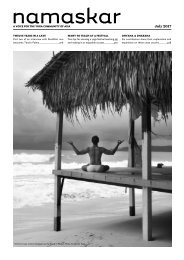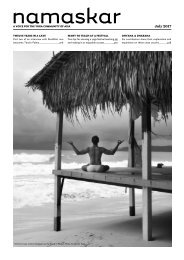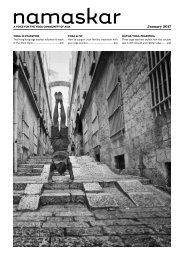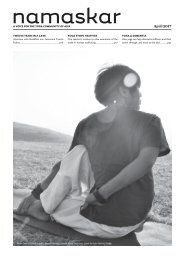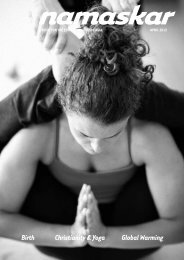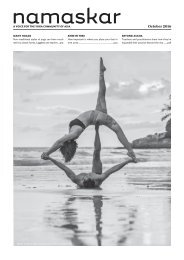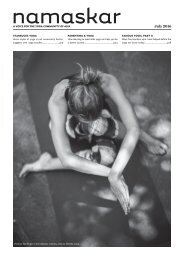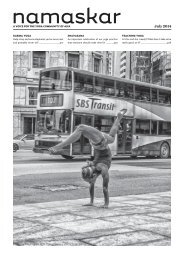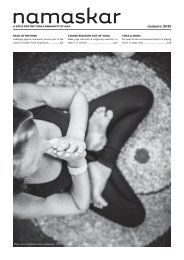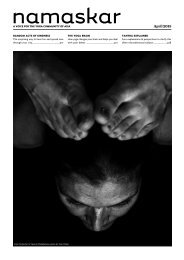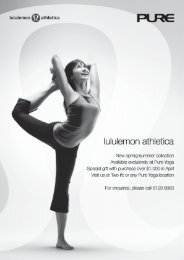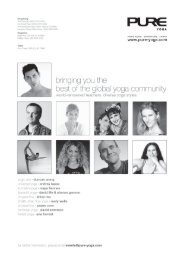You also want an ePaper? Increase the reach of your titles
YUMPU automatically turns print PDFs into web optimized ePapers that Google loves.
<strong>Namaskar</strong> • A Voice for Yoga in Asia<br />
Dristi Letting Go<br />
Thich Naht Hahn. I start on the inhale and breath twice,<br />
repeating mentally: “inhaling, I calm my body, exhaling, I<br />
smile. Dwelling in the present moment, I know this a perfect<br />
moment.”<br />
“You have a choice. You can<br />
either choose to see that<br />
everything is a miracle, or<br />
that there are no miracles.”<br />
Anytime you need a little more peace and joy please try<br />
this. It can be applied and repeated anytime or place.<br />
The idea that this is a perfect moment is a great example of<br />
letting go completely, of aparigraha. You see each moment,<br />
but then it is gone. You can not hold on to it. If you do, you<br />
get stuck. Instead, simply breathe and see each moment as<br />
a perfect moment and you will have the key to being happy.<br />
Albert Einstein once said, and I paraphrase, “You have a<br />
choice. You can either choose to see that everything is a<br />
miracle, or that there are no miracles.” Personally I find it<br />
much more enjoyable to live in a miraculous universe. When<br />
I choose to see it is all a miracle, there is no reason to hold<br />
on too much to any one part of it.<br />
Holding on to something rigidly, including one’s thoughts, can<br />
result in a loss of our ability to appreciate the present<br />
moment and see where we’re going. Whereas simply being<br />
present gives us the power to determine our state, to move<br />
from stress into bliss. Thus we can start to see how we<br />
create our state and how we are borne. We can learn more<br />
about how our influence on reality works, and appreciate the<br />
lessons of the past, use the present in a worthwhile way, and<br />
plan for a future life of greater contentment.<br />
Dylan teaches and lives in Rayong, Thailand, a coastal<br />
city about three hours from Bangkok. There he is<br />
helping open a new w studio called Blis<br />
liss s Hot t Yoga and<br />
invites all to come practice by the beaches of Rayong.<br />
dylanniall@yahoo.com<br />
Good and Bad<br />
Pain ain in Yoga<br />
Laura a Walsh<br />
Pain is universal. We’ve all felt, at some<br />
point and to some degree, what the<br />
Encyclopaedia Britannica defines as “a<br />
physical response to a harmful stimulus<br />
followed by an emotional response to that event”. What is<br />
unique, though, is our personal interpretation of this<br />
experience called pain. It turns out pain is more of a<br />
perception and less of an automatic response to your body<br />
being hurt. According to psychologist Dennis Turk, ‘“pain<br />
affects our thoughts, memories, attitudes and emotions,<br />
movements and behaviours and in turn is affected by all of<br />
these”. Many experts believe, including my son’s karate<br />
instructor, pain to be an amazing teacher. “Pain is neither<br />
good nor bad. It’s your body’s way of telling you something<br />
interesting is happening”, shouts Si Fu as he guides his<br />
martial arts class. Others, including Sravaniya DiPecoraro<br />
and Michel Besnard, both yoga teachers for more than 20<br />
years, agree. “When pain comes up, you’re learning”,<br />
explains Sravaniya. This is not to say pain is a figment of<br />
our imagination and doesn’t really exist. Far from it. Pain is<br />
a real survival tool our bodies use to warn and protect us<br />
from harm. The goal when you practice yoga, is to<br />
distinguish between a pain that leads to an injury, from a<br />
pain sending you feedback on whether your body’s ready for<br />
a certain asana or if you’re even doing the posture properly.<br />
Sport or exercise in general, including Hatha yoga, will<br />
always produce some physical aches and pains. For a<br />
muscle to become stronger, it must be stressed at a higher<br />
level than it’s used to. Often referred to as “the burn”, it’s a<br />
sign the individual has pushed their physiology. As long as<br />
this discomfort disappears within a few minutes to a few<br />
hours and is followed by rest, health and fitness experts<br />
agree this type of “pain” is okay. Another form of muscle<br />
soreness occurring during exercise is called “delayed onset<br />
muscle soreness” or DOMS. Muscles that haven’t been<br />
exercised for long periods of time, respond to increases in<br />
10



